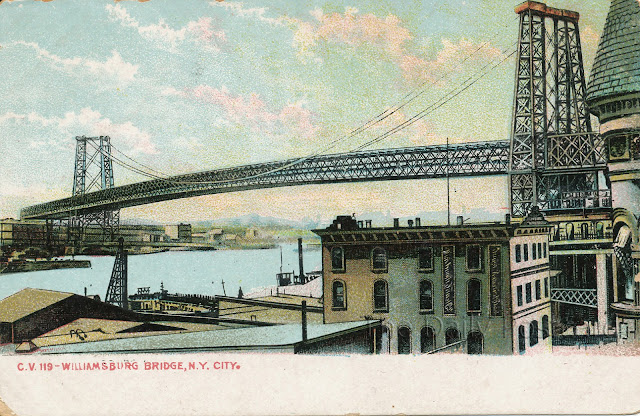This week's
Sepia Saturday theme has to do with bridges. That started me thinking about various bridges and their durability. I had visions of the
Tacoma Narrows Bridge swaying and twisting in the wind and the collapse of the Honeymoon Bridge near Niagara Falls.
And then there's the iconic Brooklyn Bridge, still standing today. It was completed in 1883 and is one of the oldest suspension bridges in the United States. This is a tiny little (1.75" x 2.75") view card that fits inside an equally tiny folder with a number of other views as a souvenir from a visit to New York. Despite the diminutive size, it is magical and a little haunting.
One of the best features of the Brooklyn Bridge is the pedestrian promenade, which allows large numbers of people to cross the bridge above the automobile traffic. Although the original bridge designers probably didn't foresee the importance of the promenade for transit strikes, traffic issues, and calamities, it has proved to be extremely useful in ensuring that people could cross the bridge during these events, perhaps most notably following the terrorist attacks of 9/11.
A bridge built in 1883 doesn't seem so old when you contrast it with a bridge built by the Romans in 134 AD. Here is my father standing on the Ponte Sant'Angelo in Rome. Both father and bridge have withstood the tests of time very well.
And here is my mother standing in front of the sandstone bridge across the Neckar River in Heidelberg, Germany. This is a bridge with many incarnations. The original wood bridge was built in 1284, but fell victim to high water and ice, as did a number of bridges that followed it. A stone bridge was built in 1786, and lasted until it was partially destroyed in 1945. The bridge was quickly rebuilt, but has now been added to the
World Monuments Fund, a list of the world's most endangered monuments. I am certain that I bear responsibility for this status, because as a child when we lived just down the Neckar, my friend and I would scratch our initials and whatever else into the sandstone with a stick. It's amazing how soft sandstone is. Even then I wondered how a sandstone bridge could hold up to the elements.
And then there are bridges that are never intended to be anything but temporary. Here is my brother with a self-built bridge across a creek in Oregon. Rest assured that he did not go on to become an engineer.
































